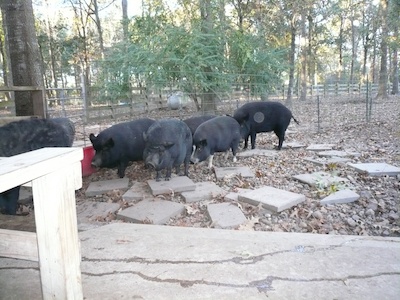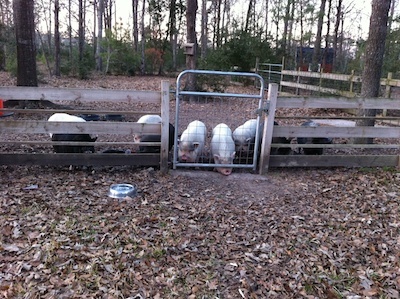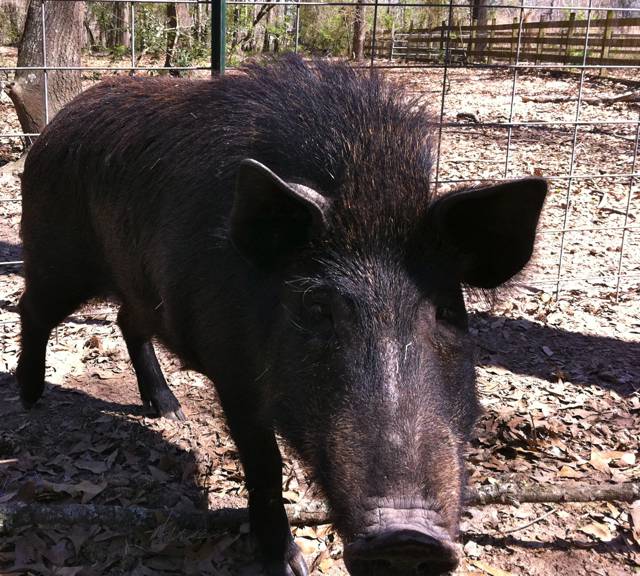Animal Rescue
My wife and I have an animal sanctuary (Yes, we rescue animals.) We’ve had it for about twenty-five years. My wife gets asked all the time “What’s life on an animal sanctuary like?” “What led you to start it?” “Why do you do animal rescue?” “What kind of animals do you have?”
Some of those questions are easy.
- What kinds of animal rescue do you do?—dogs, cats, pigs, horses, and one crazy wild boar.
- Why do you rescue animals?—This is also an easy answer. These animals needed help, and they show their appreciation.
- What started you off on animal rescue? This requires some page time, so I’ll address it in another post.
- What is life like on an animal sanctuary? Aren’t animal sanctuaries expensive?
Many people have said to us “I’d love to do that.” And that’s just what we thought twenty-five years ago. But there is a lot to consider. Let’s look at a few of the reasons why life on an animal sanctuary may not be for everyone.
The Gory Details of Life on an Animal Sanctuary
- It’s expensive.
- No matter how you slice the pie, keeping animals, especially ones who need medical attention is costly. Let’s look at some of the expenses.
- Feed—we spent about $1,000 per month on feed alone, though at that time we had about 55 animals.
- Vet bills—these are rescue animals. Some of them need medical attention immediately, but all of them will need attention at some time. If you have 55 animals, and they only have to see a vet twice in their life (not realistic) that’s still 110 vet bills. You do the math. For a rescue cat we found, we had to spend $4,000 immediately, though it’s been worth it. See the blog I wrote about it here. Another dog we had was afflicted with some rare fungal disease. We ended up spending more than $6,000 on him.
- Shelter-when you have 55 animals, they’re not all going to live in your house. That means barns or shelter of some kind. We have a large, 40×60 barn and two smaller 10×12 barns. We also have a shed for the horse.
- Fences—you either need fences or something else to keep the animals contained. We have almost a mile of fencing, and for long-term usage, we built it by putting 4×4 posts sunk 30″ into the ground, in concrete, then used three or four slats of 1×6 corral board, then covered that with 12 gauge hog panel. Some people may think that’s overdoing it, but we live in a place subject to frequent high winds, which blow over trees. Even this fence structure won’t prevent damage from a fallen tree, but it minimizes the damage. The main thing is it keeps the animals on the property.
- Electricity—even though it’s not as much as feed or medical, electricity costs are not insignificant. We had to increase the size of the electric box, then run lines to all the barns so the animals could have heat in the winter, and so my wife would have light if she had to go out there at night.
- Work and time. It’s a hell of a lot of work, and it takes a lot of time to care for so many animals, especially when some of them are sick or injured. And it’s not just fixing fences or barns, there always seem to be branches to pick up or leaves to rake. If a fence breaks, it must be repaired immediately, before animals can get out. That means no matter what you had planned for that day, it has to be put on hold. And of course, you’re not allowed to be sick. Animals still have to eat, so when you feel bad, buckle up and get to it because they’re waiting to be fed.
- When things go wrong, the work increases. During the droughts (and Texas has had a few), water must be hauled from the pond to the animals (usually with the tractor). We have a well, so it gets affected by droughts as well. And when it’s cold (which isn’t often in Texas), you still have to provide water, and it gets damn cold when you get wet.
- Below are two pictures. The first shows a group of pigs coming when I called them to eat, and the second shows another group, who is always waiting.
Besides feeding (usually twice a day), there is medical attention, watering (especially during the summer), and repairs to the barns, fences, etc.
- Vacation—or lack of it. My wife and I have not had a vacation in more than twenty years. It’s difficult to find someone to feed and care for so many animals, especially the variety we have. Just think how difficult it is to find someone to watch one or two pets. Now imagine 50+. Besides, Dennis, our wild boar, is not fond of strangers. And trust me, you do not want to be on Dennis’s bad side. Below is a picture of him when he was about fourteen months old.
4. Heartbreak—this may be the most difficult. While these animals bring you true joy, that same emotion is turned upside down when something happens. After a long while, you begin to feel as if they’re almost family, so imagine losing a family member every couple of months (on average). Last year alone, we lost eight animals. Below is a picture of one of my favorite dogs on her last day.
–
And it’s not just losing them—it’s having to make the decision of whether to put them down. The vets are too often ready to pull the plug at an early stage. But you don’t want to wait too long either. Once that decision is made, the worst part must be faced. At least the worst part for me—burying them. I don’t like the thought of burying them, let alone having to do it.
Bottom Line
Now that I’ve told you all the reasons why you may not want to experience life on an animal sanctuary, let me tell you why we do it.
The animals need someone to care for them.
Most of these animals have been abused or mistreated in some way, or simply abandoned, and they need someplace to go. At first, I wouldn’t have believed it, but after so many years, it’s now obvious—they are grateful, and they show it. Animals have feelings and emotions not unlike humans, and it’s a sin to think how we treat them at times.
I will go to my grave thankful that my wife talked me into starting this sanctuary. I’ve made a lot of long-lasting friends.
If you enjoyed this post, please share.
Giacomo Giammatteo is the author of gritty crime dramas about murder, mystery, and family. And he also writes nonfiction books including the No Mistakes Careers series as well as books about grammar, publishing., and children’s fiction and nonfiction.
When Giacomo isn’t writing, he’s helping his wife take care of the animals on their sanctuary. At last count, they had forty animals—seven dogs, one horse, six cats, and twenty-five pigs.
Oh, and one crazy—and very large—wild boar, who used to take walks with Giacomo every day.
He lives in Texas where he and his wife have an animal sanctuary with forty-five loving “friends.”






